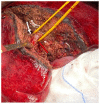Imaging Features of Main Hepatic Resections: The Radiologist Challenging
- PMID: 36675795
- PMCID: PMC9862253
- DOI: 10.3390/jpm13010134
Imaging Features of Main Hepatic Resections: The Radiologist Challenging
Abstract
Liver resection is still the most effective treatment of primary liver malignancies, including hepatocellular carcinoma (HCC) and cholangiocarcinoma (CCA), and of metastatic disease, such as colorectal liver metastases. The type of liver resection (anatomic versus non anatomic resection) depends on different features, mainly on the type of malignancy (primary liver neoplasm versus metastatic lesion), size of tumor, its relation with blood and biliary vessels, and the volume of future liver remnant (FLT). Imaging plays a critical role in postoperative assessment, offering the possibility to recognize normal postoperative findings and potential complications. Ultrasonography (US) is the first-line diagnostic tool to use in post-surgical phase. However, computed tomography (CT), due to its comprehensive assessment, allows for a more accurate evaluation and more normal findings than the possible postoperative complications. Magnetic resonance imaging (MRI) with cholangiopancreatography (MRCP) and/or hepatospecific contrast agents remains the best tool for bile duct injuries diagnosis and for ischemic cholangitis evaluation. Consequently, radiologists should be familiar with the surgical approaches for a better comprehension of normal postoperative findings and of postoperative complications.
Keywords: diagnosis; hepatic resections; liver; postoperative complications.
Conflict of interest statement
The authors have no conflict of interest to be disclosed. The authors confirm that the article is not under consideration for publication elsewhere. Each author has participated sufficiently to take public responsibility for the content of the manuscript.
Figures









References
-
- Granata V., Grassi R., Fusco R., Setola S.V., Belli A., Ottaiano A., Nasti G., La Porta M., Danti G., Cappabianca S., et al. Intrahepatic cholangiocarcinoma and its differential diagnosis at MRI: How radiologist should assess MR features. Radiol. Med. 2021;126:1584–1600. doi: 10.1007/s11547-021-01428-7. - DOI - PubMed
Publication types
LinkOut - more resources
Full Text Sources

